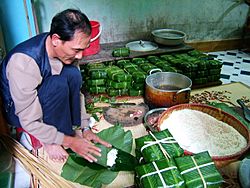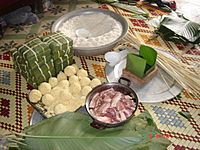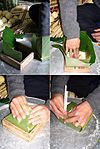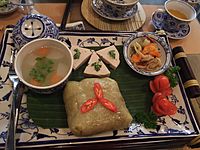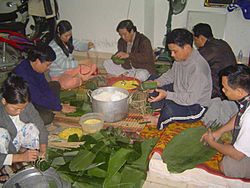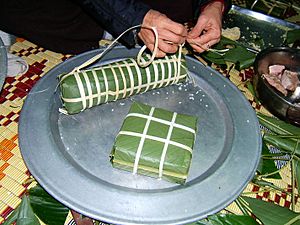Bánh chưng facts for kids
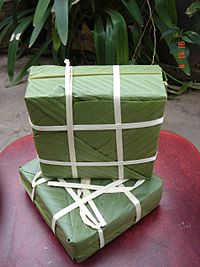
A pair of bánh chưng wrapped in lá dong ready to be steamed
|
|
| Course | Main course |
|---|---|
| Place of origin | Vietnam |
| Region or state | Southeast Asia |
| Serving temperature | Hot, room temperature, fried |
| Main ingredients | Glutinous rice, mung bean, pork |
| Other information | Traditionally consumed during Tết |
| Bánh chưng | |
| Vietnamese alphabet | Bánh chưng |
|---|---|
| Chữ Nôm | 餅蒸 |
Bánh chưng is a special traditional food from Vietnam. It's made from sticky glutinous rice, mung beans, pork, and other tasty ingredients.
The story of bánh chưng comes from an old legend. It says that Prince Lang Liêu, a son of the Sixth Hùng King, created bánh chưng and another cake called bánh giầy. These cakes were very important because bánh chưng represented the earth, and bánh giầy represented the sky. Because of his clever creation, Lang Liêu became the next king!
Today, bánh chưng is a super important part of the family altar during Tết, which is the Vietnamese New Year. Making and eating bánh chưng during this time is a tradition that Vietnamese people have kept alive for a very long time. You can also enjoy bánh chưng all year round as a delicious Vietnamese meal.
Contents
The Story Behind Bánh chưng
According to an old book from 1695 called Lĩnh Nam chích quái, Prince Lang Liêu created bánh chưng. He was a prince of the Sixth Hùng Dynasty.
The king wanted to choose his next ruler. He decided to hold a competition. Each prince had to bring a special dish that showed their respect for their ancestors during Tết. The prince who brought the most delicious dish for the altar would become the new king.
Other princes searched for rare and fancy foods from forests and the sea. But Lang Liêu, who was the poorest son, couldn't afford such expensive ingredients. He had to use everyday foods like rice and pork.
With these simple ingredients, he created two cakes. One was square, like the earth, and he called it bánh chưng. The other was round, like the sky, and he called it bánh giầy.
When the Hùng King tasted his son's dishes, he was amazed! The cakes were not only tasty but also showed great respect for their ancestors. So, the king chose Lang Liêu to be the next ruler. From then on, bánh chưng and bánh giầy became traditional foods for Tết. Lang Liêu then started the Seventh Hùng Dynasty.
Bánh chưng is a must-have dish for Tết. Families place it on their altars to honor their ancestors. They also pray for good luck and support in the new year. The green, square shape of bánh chưng stands for the earth. Its ingredients, which come from nature, also show how important bánh chưng is to Vietnamese people.
What's Inside and How It's Made
To make bánh chưng, you need a few key ingredients. These include glutinous rice, mung beans, fatty pork, black pepper, and salt. Sometimes, green onion and nước mắm (fish sauce) are added for a salty taste.
For wrapping, people use special lá dong leaves. These leaves are common in Southern Asia. If lá dong isn't available, banana leaves or lá bàng can be used instead. Thin strings from a type of bamboo called giang are used to tie the cake.
The lá dong leaves and giang strings must be washed very carefully. This helps keep the cake tasting fresh. The giang strings are often soaked or steamed to make them soft and easy to tie.
People usually pick high-quality rice and beans. The mung beans are soaked in water for about 2 hours. The glutinous rice needs to soak for a longer time, about 12 to 14 hours. After soaking, the mung beans are drained, cooked, and mashed into a smooth paste.
Fatty pork is preferred for bánh chưng. Its rich flavor goes well with the sticky rice and mung beans. The pork is cut into thick strips. Then, it's mixed with pepper, onion, salt, and fish sauce. Some people also add a little sugar to this mix.
Here's how the cake is wrapped:
- First, the giang strings and two lá dong leaves are laid out to form a square base.
- Next, a layer of glutinous rice is placed on the leaves.
- Then comes a layer of mung bean paste, followed by the seasoned pork.
- More mung bean paste is added, and finally, another layer of rice. This makes sure the bean and pork are in the middle of the cake.
- The ingredients are carefully folded and wrapped tightly in the lá dong leaves.
- Finally, the giang strings are used to tie the package into a neat square shape.
Some people use a square wooden mold to help get a perfect shape. Wrapping the cake very tightly helps prevent it from getting moldy or spoiling quickly.
Once wrapped, the cakes are placed in a large pot. They are then boiled for many hours until they are fully cooked. As the water boils away, more hot water is added to keep the cakes covered. The outer layer of rice turns green because it absorbs the color from the lá dong leaves.
A bánh chưng is often cut into 8 triangle pieces or 9 square pieces. People usually use the same giang string that tied the cake to cut it! Since it has many ingredients, each bite of bánh chưng can taste a little different. You'll get flavors from the rice, pork, beans, and even the lá dong leaves.
Bánh chưng is often served with pickled onions or vegetables, chả lụa (Vietnamese sausage), and nước mắm. If you keep it in the refrigerator, an unwrapped bánh chưng can last for several days. An unopened one can last up to two weeks! You can also freeze bánh chưng, but it might not taste as fresh when thawed.
- ''Bánh chưng'' examples
-
Bánh chưng is served with chả lụa and other dishes
History and Traditions
Bánh chưng is always seen as a key part of a traditional Tết celebration. A popular poem describes it:
Vietnamese: Thịt mỡ, dưa hành, câu đối đỏ
Cây nêu, tràng pháo, bánh chưng xanh
Translation: Rich meats, pickled onions, red couplets
Nêu tree, firecracker, green bánh chưng
Traditionally, making bánh chưng takes a lot of preparation. Many Vietnamese families start making the cakes around the 27th or 28th day of December in the Lunar calendar. When making bánh chưng, everyone in the family helps out. They wash the lá dong leaves, mix the pork with spices, prepare the mung beans, and most importantly, wrap all the ingredients into the square shape. Then, they boil the cakes for ten to twelve hours! During this long boiling time, adults and children often sit together around the big cooking pot, sharing stories and spending time together.
In the past, in the countryside, even poor families could have bánh chưng for Tết. They would set up a special fund called họ bánh chưng. About a month before Tết, the money would be shared among the members so they could afford to make the cakes.
Today, fewer families make bánh chưng at home. Families are smaller, and people often don't have enough time for all the steps. Instead, they buy bánh chưng from special shops or order them from families who are experts at making them. So, bánh chưng is still on every family's table during Tết, but it's often bought, not homemade. Some villages, like Tranh Khúc and Duyên Hà in Thanh Trì, Hanoi, are famous for their bánh chưng making skills.
Every year, during the Death anniversary of the Hung Kings, there's a competition to make bánh chưng and bánh dày at Hùng Temple in Phú Thọ. Teams from different regions, like Lào Cai, Hanoi, and Cần Thơ, get ingredients to make 10 bánh chưng in just 10 minutes! The winning team's cakes are placed on the official altar of the festival. In 2005, bánh chưng makers in Ho Chi Minh City even made a giant pair of bánh chưng and bánh giầy for Hùng Temple. The bánh chưng was huge, measuring 1.8 meters (about 6 feet) on each side and weighing 2 tons after cooking!
Different Kinds of Bánh chưng
While bánh chưng is usually eaten warm or at room temperature, it can also be fried! This crispy fried version is called bánh chưng rán or bánh chưng chiên. The writer Vũ Bằng even wrote about how delicious fried bánh chưng was during cold February days in Hanoi.
In some parts of Vietnam, people make bánh tét instead of bánh chưng. Bánh tét is a cylindrical (tube-shaped) cake with almost the same ingredients as bánh chưng. A similar long cake is made in the North, called bánh tày or bánh chưng dài (long bánh chưng). Bánh tày usually has less mung bean and little or no pork, so it can be stored for a longer time. You can cut bánh tày into slices and fry it, just like bánh chưng rán.
The San Diu people have another type of long bánh chưng that has a hump in the middle. They call it bánh chưng "gù" ("humped" bánh chưng). Besides lá dong, this cake is also wrapped with another type of leaf called lá chít.
There are also bánh chưng variations for vegetarians and Buddhists that don't have pork. These are called bánh chưng chay (vegetarian chưng cake) or bánh chưng ngọt (sweetened chưng cake). Instead of pork, these cakes are filled with molasses or brown sugar. Sometimes, they mix the sticky rice with gac fruit, which gives the cake a pretty red color and makes it look even more delicious. In the countryside, poor families sometimes made bánh chưng chay when they couldn't afford pork. They would use cardamom, black pepper, and cooked mung bean instead, and eat it with molasses.
See also
 In Spanish: Bánh chưng para niños
In Spanish: Bánh chưng para niños


